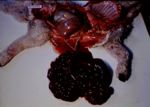Hernia
Jump to navigation
Jump to search
- A hernia is defined as the displacement of the small intestine through a normal or pathologic foramina.
- Occasionally, the large intestine is involved.
Pathogenesis
- Associated with trauma or the weakening of tissues.
- For example,
- Old age
- Pregnancy
- Straining
- Wound dehiscence.
- For example,
- Most hernias are external
- Contents pass through a hernial ring in the abdominal wall.
- Are covered with parietal peritoneum, soft tissue and skin.
- A hernial sac.
Sequelae
- The sequelae depend on whether the hernia is reducible, or is an incarceration.
Reducible hernia
- The hernial contents are freely moveable.
- There are NO sequelae.
Incarceration
- The small intestine contents are trapped.
- The hernia is non-reducible.
- Venous drainage is obstruced.
- Oedema
- Congestion
- Adhesions form between the contents and the sac.
- Accumulated gas/ ingesta distends the herniated viscus.
- Obstruction of lumen leads to
- Rupture
- Peritonitis
- Death.
Types of hernia
- Umbilical - usually congenital.
- Diaphragmatic - common following road traffic accidents in the dog and cat.
- Inguinal/scrotal - may be:
- Congenital
- Acquired
- E.g. post castration of stallion
- Perineal - old male dogs with prostate enlargement.
- Ventral -wound site breakdown, old mares
- Omental/mesenteric - internal hernias.

